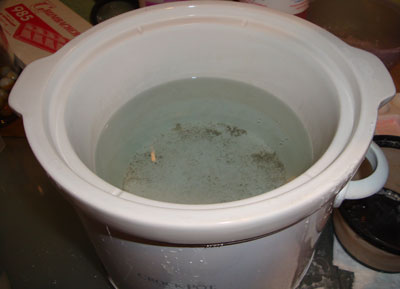As jewellers, have to keep our metal clean. We depend on our pickle pot, day after day, to clean and remove copper from our newly soldered pieces, uncovering the beauty of our creative visions. We probably don’t think about it that much until one day, we realize that it’s turned blue and crystalline! Ah, time for new pickle, we say, as we blithely dump it down the drain, unaware of the toxicity of the liquid that we’ve just thrown away.

Toxic?! The blue colour comes from all the copper oxides that have been removed by the pickle. There’s even copper in pickle that hasn’t turned blue. This copper is extremely toxic to fish and aquatic life in general. Dumping on the ground is no better, as it can leach into the water table and make its way to rivers and lakes. So, how do you dispose of it in an environmentally-friendly manner? It takes a bit of work, but in my view it’s worth it to protect the earth and all the critters we share it with.
First of all, you can check to see if your city will take the pickle at their recycling centre. If they do, make sure that you have written on the container what kind of pickle it is (ie: sodium bisulfate) and that it is contaminated with copper.
If that option is not available, you can treat it yourself with calcium hydroxide to remove the copper and neutralize the acid. You pour the pickle into a deep bucket and check the pH with a pH strip. Make a note of the number. Next, you make a smooth mixture of water and calcium hydroxide. Then, slowly add the mixture to the pickle while stirring. The goal is to produce a pH reading of 9, but no higher than 10. Check it carefully with a pH strip to make sure it’s not over. This is because between pH 9 and 10 the copper is pulled out of the pickle as a solid precipitate and sinks to the bottom of the bucket when left overnight. If you are successful, there will be a layer of clear liquid on top and a blue-green sludge on the bottom. If it hasn’t worked, add more calcium hydroxide or a bit of fresh pickle to get to where you need to be. The secret is to add the calcium hydroxide slowly and check often with pH strips so you don’t overshoot the desired pH.
You can now carefully pour off the clear liquid down the sink. The solids can be left to dry out completely or you can add kitty litter to absorb all the remaining moisture. Bag it up and put it in the trash, and that’s it!
The difficult part ia finding a source for calcium hydroxide. The only place I have been able to actually locate any is at Home Hardware. It is called hydrated lime and sells for $15.49 for a six kilo bag, Interestingly enough, it is also used in the manufacture of tortilla chips. (look on the back of the bag) I don’t think that you can use tortilla chips for this application, unfortunately.
The information above is taken from an article in the August 2016 issue of “Lapidary Journal Jewelry Artist”. Instructions can also be found online at shoeboxstudio.com
On behalf of the fish and other sea creatures, 
